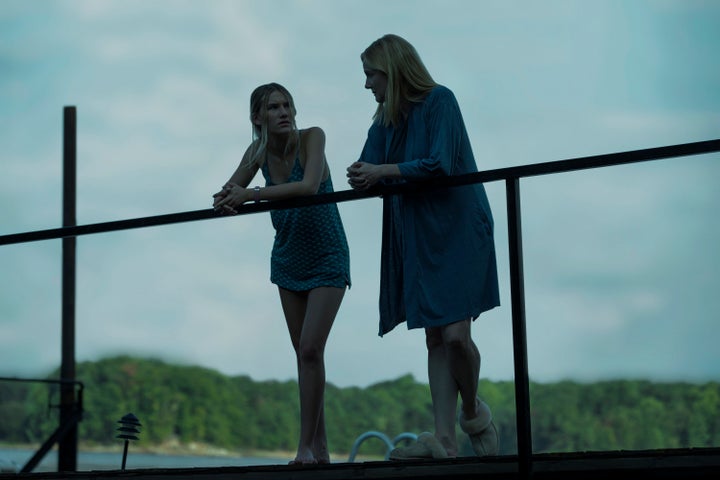What’s a guy to do when his longterm money laundering partner is killed off by his drug cartel boss? Pick up his family and move to the Ozarks, promising said drug cartel boss that even more laundering opportunities abound as the summer resort season approaches.
That’s the situation Jason Bateman, playing beleaguered ex-financial planner Marty Byrd, finds himself in at the start of Netflix’s newest drama, “Ozark.” (The “Z” is stylized like a dollar sign in case you forget about the whole money thing while watching.) And while Marty’s ill-advised scheme could conceivably play out anywhere in the country — hey, it worked for him for a good long while in Chicago — the setting where he transplants his family enhances the tensions at play in a fascinating way.
“It’s a different place June through August than it is the rest of the year,” showrunner Chris Mundy said of the Ozarks, a real-life highland region largely in Missouri where many from the Chicago, St. Louis and Kansas City areas go to vacation in the summertime.
The town where the Byrd family lands is economically depressed, with a good chunk of its full-time residents living below the poverty line or skirting it. Meanwhile, during the summer months, tony families with enough funds for yachts and dining out and visits to the local strip club swarm the area, acting as both a necessary boon for the locals and a thorn in their side.
“Missouri’s smack dab in the middle of the country,” Mundy explained. “[It] is one of those states that in some ways it’s very Midwestern, in some ways it’s pretty Southern. It really serves to be a lot of different things naturally.”
The Byrd family straddles the divide between the two classes in their Ozark town, requiring the approvals of both the locals and the tourists. Marty needs to be able to hide in plain sight and yet stake enough of a claim in local businesses in order to successfully “wash” money for the drug cartel. If he doesn’t? Marty, his wife, his kids — all of them could be dead before you can say “coastal elites.”
Of course, that ridiculously high ask comes with complications: Along the way, there are FBI agents on Marty’s tail, a body that floats up to his dock, close calls with the local crime syndicate. Marty’s kids, too, struggle to adjust in the new landscape. Charlotte, the teenage daughter, follows a preppy kid to “Party Cove” with damaging results, and Jonah, the middle-school-aged son, begins using animal carcasses to attract vultures in order to study them.
“The Ozarks are a place where you get young, old, rich, poor people from the big cities [...] but also people from smaller towns,” Mundy explained. “It was a real mix. You could play with that without having to be really on the nose about it.”

Mundy, who is from the “middle of the country” along with series creator Bill Dubuque, makes it clear that the show was not meant as a cynical view of the rural Midwest.
“It was really important to us that everybody in [the show] have their sort of dignity, that everyone was intelligent in their way,” said Mundy. “If anyone was going to underestimate someone, it was going to be the Byrds underestimating the locals there. The Byrd family were the ones that needed to better understand things, not the other way around.”
There are elements of a resort town that play directly into the storyline of “Ozark.” For example, there’s a priest who conducts his sermons on the water from a boat with a cross affixed to it, a character borne out of Mundy’s time spent in the area — “one of the guys we met down there just mentioned that,” he said. At one point, Julia Garner’s character, a scrappy and intelligent young woman born into an unfortunate family, tries to rig Marty’s dock so it electrocutes him.
“The lake is beautiful, but the lake is dangerous,” Mundy explained, noting that this duality of nature was a key focus in the “Ozark” writers room. “The woods are beautiful but the woods are dangerous.”
The separateness of lake life bleeds into smaller moments, too: watching Laura Linney’s Wendy fiddle with her car radio, grumbling when only country and religious stations come in on the receiver, is a moment all too relatable to any road trip participant. That small gesture is a reminder that getting away from it all has a downside. On the one hand, you’re all alone. On the other hand, you’re all alone.
In any given moment on the show, the landscape is both pristine and isolating, both inviting and eerie.
“We always wanted to sort of get at the ugliness beneath the beauty, or the beauty inside the ugliness,” Mundy continued. “The terrain is ripe for that, so we tried to use it as much as we could.”
The smaller tensions at play are what attracted Mundy to the project.
“To us, it was really about: Can this family stay together?” he said. “Can they hold together? And that interested me. It wasn’t about crime moves.”
The entire first season of “Ozark” is now streaming on Netflix.
